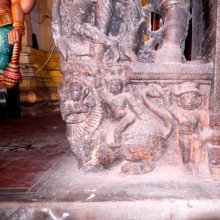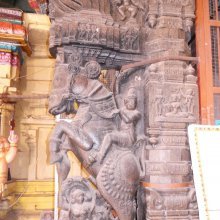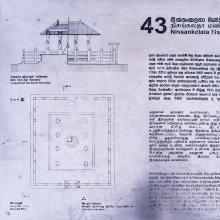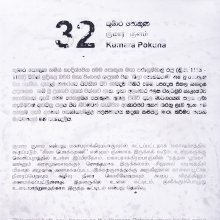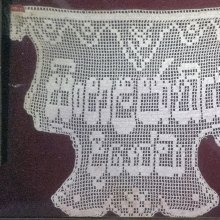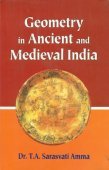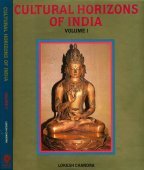Alamkara, Alaṅkāra, Alaṃkāra, Alankara, Alam-kara: 36 definitions
Introduction:
Alamkara means something in Buddhism, Pali, Hinduism, Sanskrit, Marathi, Jainism, Prakrit, Hindi. If you want to know the exact meaning, history, etymology or English translation of this term then check out the descriptions on this page. Add your comment or reference to a book if you want to contribute to this summary article.
Alternative spellings of this word include Alankar.
Images (photo gallery)
(+6 more images available)
In Hinduism
Natyashastra (theatrics and dramaturgy)
Source: Wisdom Library: Nāṭya-śāstra1) Alaṃkāra (अलंकार) refers to the “figures of speech” in dramatic compositions (kāvya), according to Nāṭyaśāstra chapter 17.
There are four alaṃkāras defined:
- upamā (simile),
- rūpaka (metaphor),
- dīpaka (condensed expression),
- yamaka.
2) Alaṃkāra (अलंकार) refers to the “ornaments” of six kinds, according to the Nāṭyaśāstra chapter 19:
- ucca (high),
- dīpta (excited),
- mandra (grave),
- nīca (low),
- druta (fast),
- vilambita (slow)
3) Alaṃkāra (अलंकार, “decoration”) refers to one of the categories of nepathya, or “costumes and make-up”, according to Nāṭyaśāstra chapter 23. The perfection of Nepathya forms the main concern of the Āhāryābhinaya, or “extraneous representation”, a critical component for a successful dramatic play.
Alaṃkāra (‘decoration’) is of three different types:
- mālya (flower-garlands),
- ābharaṇa (ornaments),
- vāsas (drapery).
4) Alaṃkāra (अलंकार “ornaments”) refers to the “grace of a young women”, according to Nāṭyaśāstra chapter 24. It supports the use of sentiments (rasa) in a drama and consist of changes in respect of their faces and other limbs.
It is of three kinds:
- change of limbs (aṅgaja) is of three kinds,
- the natural (sahaja) change of ten kinds,
- involuntary (ayatnaja) change, of seven kinds.
5) Alaṃkāra (अलंकार) refers to “embellishments” of songs, according to the Nāṭyaśāstra chapter 29. The alaṃkāras depend upon the four kinds of varṇas, which is a specific order, or sequence, of musical notes (svara).
The thirty-three alaṃkāras are:
- prasannādi,
- prasannānta,
- prasannādyanta,
- prasannamadhya,
- sama,
- bindu,
- veṇu,
- nivṛttapravṛtta,
- kampita,
- kuhara,
- recita,
- preṅkholitaka,
- mandratāraprasanna,
- tāramandraprasanna,
- prasvāra,
- prasāda,
- udvāhita,
- avalokita,
- krama,
- niṣkujita,
- udgīta,
- hrādamāna,
- rañjita,
- āvarta,
- parivartaka,
- udghaṭṭita,
- ākṣipta,
- sampradāna,
- hasita,
- huṃkāra,
- sandhipracchādana,
- vidhūna,
- gātravarṇa.
According to the Nāṭyaśāstra, “these alaṃkāras attached to songs of seven forms, should be known to the wise. These however are not generally used (lit. desired) in the dhruvās, because of their giving prominence to the varṇas of jātis which are not used there”.
Source: Academia.edu: The Nāṭyaśāstra: the Origin of the Ancient Indian PoeticsThe six ornaments (alaṃkāra) comprise the use of:
- highpitched sounds (ucca),
- deep and colourful sound (dīpta),
- the use of descending (mandra)
- and especially low pitches (nīca),
- and an emphasized speed (druta)
- or slowness (vilambita) of recitation.
Alaṃkāra (अलंकार) refers to the “the figures of speech”.—The word alaṃkāra stands for a thing of beauty. The rhetoricians deal with the alaṃkāras in detail and the poets use them profusely in their works. Alaṃkāra has an ancient origin. Vāmana (Kāvyālaṃkārasūtravṛtti 1.1.1) is of the opinion that poetry should be accepted from the perspective of alaṃkāra. Daṇḍin also uses the word in a broader meaning. Mammaṭa (Kāvyaprakāśa VIII.67) defines alaṃkāra briefly as strikingness. When this strikingness relates to sound only, it is called śabdālaṃkara, when it relates to sense only, it is termed as arthālaṃkāra and when it relates partly to sound and partly to sense, and it is then called the ubhayālaṃkāra.
According to Viśvanātha Kavirāja (Sāhityadarpaṇa X.1), alaṃkāra increases the impressiveness of a poem, as like the ornaments such as bracelets, anklets, ear-rings etc. enhance the beauty of an individual. Viśvanātha mentions that the alaṃkāra benefits rasa or sentiment.The alaṃkāras are the transitory attributes of a word and its sense and they are like the parts of human body. They are said to be the cause of excellence of rasa. According to Bharata (Nāṭyaśāstra XVII.43), four alaṃkāras are there in literature viz. Upama, Dīpaka, Rūpaka and Yamaka.
Source: Shodhganga: Elements of Art and Architecture in the Trtiyakhanda of the Visnudharmottarapurana (natya)Alaṃkāra (अलंकार) refers to one of the four kinds of “costume and make up” (in Indian Dramas) which are included under Āhāryābhinaya: one of the four divisions of Abhinaya or “ways to convey or represent one’s emotion to others”, according to the Viṣṇudharmottarapurāṇa, an ancient Sanskrit text which (being encyclopedic in nature) deals with a variety of cultural topics such as arts, architecture, music, grammar and astronomy.—Alaṃkāra deals with the decoration of garlands and ornaments. In the Nāṭyaśāstra four kinds of ornaments and five kinds of garlands are accepted. In the Sanskrit dramas ornaments like ear-rings, bracelets, head-gears etc. are seen to be collected from nature.

Natyashastra (नाट्यशास्त्र, nāṭyaśāstra) refers to both the ancient Indian tradition (shastra) of performing arts, (natya—theatrics, drama, dance, music), as well as the name of a Sanskrit work dealing with these subjects. It also teaches the rules for composing Dramatic plays (nataka), construction and performance of Theater, and Poetic works (kavya).
Purana and Itihasa (epic history)
Source: Cologne Digital Sanskrit Dictionaries: The Purana IndexAlaṅkāra (अलङ्कार).—Depend on varṇa, sthānayoga and nāṭya Three places of origin—neck, head and mind: 4 varṇas, eight vikalpas, and sixteen deities: Different kinds of, described:1 300 varieties distinguished.2

The Purana (पुराण, purāṇas) refers to Sanskrit literature preserving ancient India’s vast cultural history, including historical legends, religious ceremonies, various arts and sciences. The eighteen mahapuranas total over 400,000 shlokas (metrical couplets) and date to at least several centuries BCE.
Mīmāṃsā (school of philosophy)
Source: Srimatham: Mīmāṃsa: The Study of Hindu ExegesisAlaṅkāra (अलङ्कार, “rhetoric”) refers to one of the various tools used by authors displaying their skill in the art of writing.—Rhetoric (alaṅkāra) is the art or technique of persuasion through speech or writing. Rhetoric in literature is called alaṅkāra or “decoration” because of the use of many symbolic and colorful forms of speech, none of which need to be taken literally but understood terms of the theme under discussion.
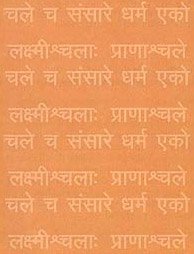
Mimamsa (मीमांसा, mīmāṃsā) refers to one of the six orthodox Hindu schools of philosophy, emphasizing the nature of dharma and the philosophy of language. The literature in this school is also known for its in-depth study of ritual actions and social duties.
Kavya (poetry)
Source: Shodhganga: Mankhaka a sanskrit literary geniusAlaṃkāra (अलंकार) or Laṅkaka was one of the brothers of Maṅkhaka (or Maṅkha or Maṅkhuka): the author of the Śrīkaṇṭhacarita and the Maṅkhakośa.

Kavya (काव्य, kavya) refers to Sanskrit poetry, a popular ancient Indian tradition of literature. There have been many Sanskrit poets over the ages, hailing from ancient India and beyond. This topic includes mahakavya, or ‘epic poetry’ and natya, or ‘dramatic poetry’.
Shaivism (Shaiva philosophy)
Source: Shodhganga: Iconographical representations of ŚivaAlaṅkāra (अलङ्कार) or Alaṅkārāgama refers to one of upāgamas (supplementary scriptures) of the Sahasrāgama which is one of the twenty-eight Siddhāntāgama: a classification of the Śaiva division of Śaivāgamas. The Śaivāgamas represent the wisdom that has come down from lord Śiva, received by Pārvatī and accepted by Viṣṇu. The purpose of revealing upāgamas (e.g., Alaṅkāra Āgama) is to explain more elaborately than that of mūlāgamas (e.g., Sahasra-āgama) and to include any new idea if not dealt in mūlāgamas.
Source: Shodhganga: Temple management in the ĀgamasAlaṃkāra (अलंकार) refers to “decoration of the liṅga”, representing a certain ceremony to be performed during pūjā (ritualistic worship), according to the Arcanāvidhipaṭala of Kāmikāgama.—The Ācārya also decorates the liṅga with several kinds of precious jewels according to the prescribed rules . The Āgama specifies māṇikya on Sundays, pearls on Mondays, coral on Tuesdays, emerald on Wednesdays, topaz on Thursdays, diamond on Fridays and sapphire on Saturdays. Finally, the Ācārya gives pādya, ācamana and arghya at the feet, mouth and head, with the corresponding mantra.

Shaiva (शैव, śaiva) or Shaivism (śaivism) represents a tradition of Hinduism worshiping Shiva as the supreme being. Closely related to Shaktism, Shaiva literature includes a range of scriptures, including Tantras, while the root of this tradition may be traced back to the ancient Vedas.
Kavyashastra (science of poetry)
Source: Shodhganga: The Kavyavilasa of Ciranjiva Bhattacarya (kavyashastra)Alaṃkāra (अलंकार) refers to “figures of speech” as defined by Cirañjīva Bhaṭṭācārya (fl. 17th century) in his Kāvyavilāsa.—Cirañjīva defines alaṃkāra in a very simple fashion without much intricacy. He says that those elements by which the body of poetry is adorn and without which poetry appears as devoid of beauty are known as alaṃkāras like ornaments of women. Cirañjīva has not clearly mentioned the connection of alaṃkāras with rasa. Rhetoricians like Ānandavardhana, Mammaṭa and Viśvanātha etc. have directly stated the connection of alaṃkāras with rasa.
The number of alaṃkāras has developed gradually. Bharata, the earliest known rhetorician has admitted only four alaṃkāras—
- upamā,
- rūpaka,
- dīpaka,
- yamaka.
Cirañjīva has admitted 93 alaṃkāras of which the number of śabdālaṃkāras is four. He has given a long list enumerating all these alaṃkāras.
The four śabdālaṃkāras are—
- citra,
- anuprāsa,
- yamaka,
- punaruktapratīkāśa.
The 89 arthālaṃkāras are—
- upamā,
- ananvaya,
- pratīpopamā,
- lalitopamā,
- rūpaka,
- pariṇāma,
- ullikhita,
- apahnuti,
- bhrāntāpahnuti,
- chekāpahnuti,
- paryastāpahnuti,
- kaitavāpahnuti,
- utprekṣā,
- guptotprekṣā,
- smṛti,
- bhrānti,
- sandeha,
- mīlita,
- unmīlita,
- anumāna,
- arthāpatti,
- parikara,
- parikarāṃkura,
- kāvyaliṅga,
- praharṣaṇa,
- viṣādana,
- sāmānya,
- atiśayokti,
- prauḍhokti,
- tulyayogitā,
- saṃbhāvana,
- dīpaka,
- āvṛttidīpaka,
- prativastūpamā,
- dṛṣṭānta,
- nidarśanā,
- vyatireka,
- sahokti,
- vinokti,
- samāsokti,
- śleṣa,
- aprastutpraśaṃsā,
- sāmānyaviśeṣa,
- arthāntaranyāsa,
- paryāyokti,
- stutinindā,
- nindāstuti,
- ākṣepa,
- virodha,
- virodhābhāsa,
- asaṃbhava,
- viśeṣokti,
- vibhāvanā,
- asaṅgati,
- viṣama,
- sama,
- vicitra,
- adhika,
- anyonya,
- viśeṣa,
- vyāghāta,
- guṃpha,
- ekāvalī,
- mālādīpaka,
- sāra,
- yathāsaṃkhya,
- paryāya,
- parivṛtti,
- parisaṃkhyā,
- vikalpa,
- samādhi,
- samuccaya,
- pratyanīka,
- pratīpa,
- ullāsa,
- purvarūpatā,
- tadguṇa,
- atadguṇa,
- avajñā,
- anuguṇa,
- uttara,
- pihita,
- vyājokti,
- vakrokti,
- svabhāvokti,
- bhāvika,
- bhāvikacchavi,
- udātta,
- atyukti.
Alaṅkāra (अलङ्कार) refers to “figures of speech” and represents the “essence of poetry”, and they were indispensable to a good poem.—Alaṅkāra is identified with beauty itself, not as instruments of beauty. Therefore the good poets have applied their minds in framing their verses in such an embellished form from which will make the verse beautiful. Though generally viewed as outer trappings, the alaṅkāras are natural to the Sanskrit poetry. It is, however, their judicious use, which makes the poem beautiful.

Kavyashastra (काव्यशास्त्र, kāvyaśāstra) refers to the ancient Indian tradition of poetry (kavya). Canonical literature (shastra) of the includes encyclopedic manuals dealing with prosody, rhetoric and various other guidelines serving to teach the poet how to compose literature.
Nirukta (Sanskrit etymology)
Source: Shodhganga: The Kavyavilasa of Ciranjiva Bhattacarya (nirukta)Alaṃkāra (अलंकार).—The word alaṃkāra is derived as alaṃ kṛ ghañ. This suffix ghañ can be used in bhāva as well as karaṇa (ghañ ca bhāvakaraṇayaḥ). According to the famous lexicographer Amara Siṃha, the author of the Amarakoṣa, the word alam has three different types of meaning, it may denote (a) bhūṣaṇa that is to adorn; in this sense it is always associated as a nominal suffix with the verb kṛ. (b) vāraṇa—that is to forbid; it is used as an adverb with instrumental case and (c) paryāpta—that is to be sufficient; it is also used as an adverb in which case the use of deity is prescribed by the grammarian.
Nirukta (निरुक्त) or “etymology” refers to the linguistic analysis of the Sanskrit language. This branch studies the interpretation of common and ancient words and explains them in their proper context. Nirukta is one of the six additional sciences (vedanga) to be studied along with the Vedas.
Vaishnavism (Vaishava dharma)
Source: Pure Bhakti: Arcana-dipika - 3rd EditionAlaṅkāra (अलङ्कार) or Bhūṣaṇa refers to “ornaments” and represents one of the various articles offered during worship, according to the Arcana-dīpikā (manual on deity worship), while explaining procedures performed in the morning.—According to time and place, sixteen [viz., bhūṣaṇa/alaṅkāra], twelve, ten or five articles can be employed in the worship of Śrī Bhagavān.

Vaishnava (वैष्णव, vaiṣṇava) or vaishnavism (vaiṣṇavism) represents a tradition of Hinduism worshipping Vishnu as the supreme Lord. Similar to the Shaktism and Shaivism traditions, Vaishnavism also developed as an individual movement, famous for its exposition of the dashavatara (‘ten avatars of Vishnu’).
Shaktism (Shakta philosophy)
Source: Google Books: ManthanabhairavatantramAlaṅkāra (अलङ्कार) refers to “ornaments”, according to the Śrīmatottara-tantra, an expansion of the Kubjikāmatatantra: the earliest popular and most authoritative Tantra of the Kubjikā cult.—Accordingly, while describing the Mūrti (visualized iconic form) of the goddess Mālinī: “She is like the rising sun and is blissful with wine. Very beautiful, she has five faces and is radiant with five time three eyes. She is adorned with beautiful earrings and shines with diadem and crown. She has ten arms adorned with many ornaments [i.e., nānā-alaṅkāra-maṇḍitā]. O beloved, (she holds) a bow, javelin, conch, makes the gesture of fearlessness and holds a mirror. (Such) is the divine weapon in her left hands. (She holds) a thunderbolt, arrow, snake, makes a boon bestowing gesture and holds a rosary. O goddess, such is the divine weapon (held) by (her) right (hands)”.

Shakta (शाक्त, śākta) or Shaktism (śāktism) represents a tradition of Hinduism where the Goddess (Devi) is revered and worshipped. Shakta literature includes a range of scriptures, including various Agamas and Tantras, although its roots may be traced back to the Vedas.
Pancaratra (worship of Nārāyaṇa)
Source: University of Vienna: Sudarśana's Worship at the Royal Court According to the AhirbudhnyasaṃhitāAlaṃkāra (अलंकार) refers to “adornments”, according to the Ahirbudhnyasaṃhitā, belonging to the Pāñcarātra tradition which deals with theology, rituals, iconography, narrative mythology and others.—Accordingly, “He should have the supreme Yantra constructed out of refined gold, with decorations of gems and coral and with all [the necessary] adornments (sarva-alaṃkāra-saṃyukta). Just by making this, he shall obtain territory free of disorders. Having [properly] installed it, he should respectfully worship this [Yantra] which bestows all accomplishments. [...]”.

Pancaratra (पाञ्चरात्र, pāñcarātra) represents a tradition of Hinduism where Narayana is revered and worshipped. Closeley related to Vaishnavism, the Pancaratra literature includes various Agamas and tantras incorporating many Vaishnava philosophies.
Gitashastra (science of music)
Source: Shodhganga: Elements of Art and Architecture in the Trtiyakhanda of the Visnudharmottarapurana (gita)Alaṃkāra (अलंकार) (literary: “ornaments” refers to “that which increases the beauty (of compositions)” (in Indian music).—As ornaments like kaṭaka, kuṇḍala etc. increase the beauty of a person, the words mingled with kāvya-alaṃkāra enhances the beauty of a poetic composition. In Music also when a raw composition is decorated with various melodic and rhythmic phases and are presented before the listener, those elements except the fixed composition, are regarded as alaṃkāras. The Nāṭyaśāstra also gives emphasis on the importance of alaṃkāras in Music and states as melody without alaṃkāras would be like a night without the moon, a river without water, a creeper without flowers and a lady without ornaments.
The Saṃgītaratnākara divides alaṃkāras into five groups. These are—
- sthāyīvarṇālaṃkāra—which consists of seven ālaṃkāras;
- ārohīvarṇālaṃkāra—which consists of twelve ālaṃkāras;
- avarohīvarṇālaṃkāra—which consists of twelve ālaṃkāras;
- sañcārivarṇālaṃkāra—which consists of twenty five ālaṃkāras and
- saptānyalaṃkāra—which contains seven ālaṃkāras.
The Viṣṇudharmottarapurāṇa mentions four kinds of ālaṃkāras (belonging to the sthāyīvarṇālaṃkāra found in the Saṃgītaratnākara).
- prasannādi,
- prasannānta,
- prasannādyanta,
- prasannamadhya.
Gitashastra (गीतशास्त्र, gītaśāstra) refers to the ancient Indian science of Music (gita or samgita), which is traditionally divided in Vocal music, Instrumental music and Dance (under the jurisdiction of music). The different elements and technical terms are explained in a wide range of (often Sanskrit) literature.
General definition (in Hinduism)
Source: academia.edu: Tessitori Collection I (hinduism)Alaṃkāra (अलंकार) refers to “rhetorical figures”, according to the Amaracandrikā by Sūrata Miśra (dealing with Poetics and Erotics), which is included in the collection of manuscripts at the ‘Vincenzo Joppi’ library, collected by Luigi Pio Tessitori during his visit to Rajasthan between 1914 and 1919.—Sūrata (or Sūrati) Miśra was a Brahman of Agra who has at least ten works to his credit, several of which testify to his sustained interest in poetics, understood as rhetorical figures (alaṃkāra), classification of female characters in relation to love (nāyikābheda) and esthetics (rasa). This trend is illustrated by his commentaries on Keśavdās’s Kavipriyā and Rasikapriyā, and by the present work which was composed in VS 1794 = 1737 century.
In Buddhism
Mahayana (major branch of Buddhism)
Source: academia.edu: A Study and Translation of the GaganagañjaparipṛcchāAlaṃkāra (अलंकार) refers to “adorning” (the body), according to the Gaganagañjaparipṛcchā: the eighth chapter of the Mahāsaṃnipāta (a collection of Mahāyāna Buddhist Sūtras).—Accordingly, “Son of good family, these are eight pure vigours of bodhisatvas. What are the eight? To wit, (1) vigour to adorn his body (kāya-alaṃkāra) but the body is not the objective support since it is distinguished (vikalpita) as a reflection (pratibimba); (2) vigour to accomplish proper speech although the speech cannot be perceived since it is distinguished as voidness; (3) vigour to put the thought into the state of concentration although the thought is not the objective support since it is imagined by the true state of thought; (4) vigour to attain all aspects of perfection although they cannot be perceived since they are imagined by the true nature of dharma which is the extinction of the continuous succession of thought; [...]”.

Mahayana (महायान, mahāyāna) is a major branch of Buddhism focusing on the path of a Bodhisattva (spiritual aspirants/ enlightened beings). Extant literature is vast and primarely composed in the Sanskrit language. There are many sūtras of which some of the earliest are the various Prajñāpāramitā sūtras.
Tibetan Buddhism (Vajrayana or tantric Buddhism)
Source: Brill: Śaivism and the Tantric Traditions (tantric Buddhism)Alaṅkāra (अलङ्कार) refers to an “ornament”, according to the Bhūśalyasūtrapātananimittavidhi section of Jagaddarpaṇa’s Ācāryakriyāsamuccaya, a text within Tantric Buddhism dealing with construction manual for monasteries etc.—Accordingly, “[...] If a parasol, lotus, banner, muraja drum, flagpole, ornament (alaṅkāra), a woman of the court, fish, milk, the best curd, wine, blazing fire, and fruits [are seen], then there are victory, extraordinary increase of grain, property, [the number of] sons, and other [merits], and the completion of duties. [...]”.

Tibetan Buddhism includes schools such as Nyingma, Kadampa, Kagyu and Gelug. Their primary canon of literature is divided in two broad categories: The Kangyur, which consists of Buddha’s words, and the Tengyur, which includes commentaries from various sources. Esotericism and tantra techniques (vajrayāna) are collected indepently.
Languages of India and abroad
Pali-English dictionary
Source: BuddhaSasana: Concise Pali-English Dictionaryalaṅkāra : (m.) 1. decoration; 2. an ornament.
Source: Sutta: The Pali Text Society's Pali-English DictionaryAlaṃkāra, (fr. alaṅkaroti, cp. Vedic araṅkṛti) “getting up” i. e. fitting ont, ornament, decoration; esp. trinkets, onaments D.III, 190; A.III, 239; 263 sq.; J.VI, 368; PvA.23, 46, 70 (-° adj. adorned with), 74; Sdhp.249. (Page 79)

Pali is the language of the Tipiṭaka, which is the sacred canon of Theravāda Buddhism and contains much of the Buddha’s speech. Closeley related to Sanskrit, both languages are used interchangeably between religions.
Marathi-English dictionary
Source: DDSA: The Molesworth Marathi and English Dictionaryalaṅkāra (अलंकार).—m (S) Ornament (of dress); jewels, trinkets &c.: (of language); figures, tropes, rhyme, alliteration, inversion, comparison &c. Three comprehensive genera are enumerated, each including many species; viz. śabdālaṅkāra, arthālaṅkāra, ubhayālaṅkāra. 2 Ornament gen., that which adorns or becomes: a trinket, a jewel, a virtue. Ex. kṣamā hī samarthāsa a0 hōya jaśīṃ citrēṃ hīṃ bhintīsa a0.
Source: DDSA: The Aryabhusan school dictionary, Marathi-Englishalaṅkāra (अलंकार).—m Ornament. Jewels. Figures of speech.
--- OR ---
aḷaṅkāra (अळंकार).—, &c. See alaṅkaraṇa, &c.
Marathi is an Indo-European language having over 70 million native speakers people in (predominantly) Maharashtra India. Marathi, like many other Indo-Aryan languages, evolved from early forms of Prakrit, which itself is a subset of Sanskrit, one of the most ancient languages of the world.
Sanskrit dictionary
Source: DDSA: The practical Sanskrit-English dictionaryAlaṃkāra (अलंकार).—
1) Decoration, act of decorating or ornamenting.
2) An ornament (fig. also); अलंकारः स्वर्गस्य (alaṃkāraḥ svargasya) V.1; अनुत्सेकः खलु विक्रमालंकारः (anutsekaḥ khalu vikramālaṃkāraḥ) ibid.
3) A figure of speech of which there are three kinds : -शब्द°, अर्थ° (śabda°, artha°), and शब्दार्थ° (śabdārtha°); शब्दार्थयोरस्थिरा ये धर्माः शोभातिशायिनः । रसादी- नुपकुर्वन्तोऽलंकारास्तेऽङ्गदादिवत् (śabdārthayorasthirā ye dharmāḥ śobhātiśāyinaḥ | rasādī- nupakurvanto'laṃkārāste'ṅgadādivat) || S. D.631; उपकुर्वन्ति तं सन्तं येऽङ्गद्वारेण जातु चित् । हारादिवदलंकारास्तेनुप्रासोपमादयः (upakurvanti taṃ santaṃ ye'ṅgadvāreṇa jātu cit | hārādivadalaṃkārāstenuprāsopamādayaḥ) || K. P. 8. cf. also काव्यशोभाकरान् धर्मानलंकारान् प्रचक्षते । अलंकरिष्ण- वस्ते च शब्दमर्थमुभौ त्रिधा (kāvyaśobhākarān dharmānalaṃkārān pracakṣate | alaṃkariṣṇa- vaste ca śabdamarthamubhau tridhā) ||.
4) The whole seience of Rhetoric. अलंकारः शास्त्रभेदे मण्डने (alaṃkāraḥ śāstrabhede maṇḍane)... ()| Nm.
Derivable forms: alaṃkāraḥ (अलंकारः).
--- OR ---
Alaṃkāra (अलंकार).—&c. see separately below.
Alaṃkāra is a Sanskrit compound consisting of the terms alam and kāra (कार). See also (synonyms): alaṃkṛ.
Source: Cologne Digital Sanskrit Dictionaries: Shabda-Sagara Sanskrit-English DictionaryAlaṅkāra (अलङ्कार).—m.
(-raḥ) 1. Ornament (of dress,) trinkets, jewels, &c. 2. (Of language,) A figure or theoretical expression. 3. The art of composition. E. alam ornament, kāra what makes.
Source: Cologne Digital Sanskrit Dictionaries: Benfey Sanskrit-English DictionaryAlaṃkāra (अलंकार).—i. e. alam-kṛ + a, m. 1. Trimming, [Rāmāyaṇa] 2, 40, 13. 2. Ornament, trinkets, [Daśakumāracarita] in
Alaṃkāra (अलंकार).—[masculine] ornamenting or ornament (lit. & [figuratively]).
Source: Cologne Digital Sanskrit Dictionaries: Aufrecht Catalogus Catalogorum1) Alaṃkāra (अलंकार) as mentioned in Aufrecht’s Catalogus Catalogorum:—by Dharmakīrti. Mentioned in Vāsavadattāp. 235.
2) Alaṃkāra (अलंकार):—alaṃkāra, shortened to laṅkaka, son of Viśvāvarta, brother of Maṅkha, minister of Jayasiṃha of Kāśmīr (1129 -50). Report. p. 52. Śrīkaṇṭhacarita 3, 56.
Source: Cologne Digital Sanskrit Dictionaries: Monier-Williams Sanskrit-English Dictionary1) Alaṃkāra (अलंकार):—[=alaṃ-kāra] [from alaṃ > alam] m. the act of decorating, [Rāmāyaṇa ii, 40, 13], (ifc. f., [Rāmāyaṇa 18, 6]) ornament, decoration, [Śatapatha-brāhmaṇa; Taittirīya-brāhmaṇa etc.] (in rhetoric) an ornament of the sense or the sound (cf. arthāl and śabdāl)
2) [v.s. ...] Name of a minister of Jaya-siṃha of Kaśmir (1129-1150 [Apte’s The Practical Sanskrit-English Dictionary]D.; he is also called Laṅkaka)
Source: Cologne Digital Sanskrit Dictionaries: Yates Sanskrit-English DictionaryAlaṅkāra (अलङ्कार):—(raḥ) 1. m. Ornament.
Source: DDSA: Paia-sadda-mahannavo; a comprehensive Prakrit Hindi dictionary (S)Alaṅkāra (अलङ्कार) in the Sanskrit language is related to the Prakrit word: Alaṃkāra.
[Sanskrit to German]
Sanskrit, also spelled संस्कृतम् (saṃskṛtam), is an ancient language of India commonly seen as the grandmother of the Indo-European language family (even English!). Closely allied with Prakrit and Pali, Sanskrit is more exhaustive in both grammar and terms and has the most extensive collection of literature in the world, greatly surpassing its sister-languages Greek and Latin.
Hindi dictionary
Source: DDSA: A practical Hindi-English dictionaryAlaṃkāra (अलंकार) [Also spelled alankar]:—(nm) embellishment; ornament; figure of speech; -[śāstra] Rhetorics; -[śīstrī] a rhetorician; ~[śāstrīya] rhetoric.
...
Prakrit-English dictionary
Source: DDSA: Paia-sadda-mahannavo; a comprehensive Prakrit Hindi dictionary1) Alaṃkara (अलंकर) in the Prakrit language is related to the Sanskrit word: Alaṃkṛ.
2) Alaṃkāra (अलंकार) also relates to the Sanskrit word: Alaṅkāra.
3) Alaṃkāra (अलंकार) also relates to the Sanskrit word: Alaṃkāra.
Prakrit is an ancient language closely associated with both Pali and Sanskrit. Jain literature is often composed in this language or sub-dialects, such as the Agamas and their commentaries which are written in Ardhamagadhi and Maharashtri Prakrit. The earliest extant texts can be dated to as early as the 4th century BCE although core portions might be older.
Kannada-English dictionary
Source: Alar: Kannada-English corpusAlaṃkāra (ಅಲಂಕಾರ):—
1) [noun] the act of decorating; beautification; decoration.
2) [noun] anything used for decorating; an ornament.
3) [noun] the person or thing that enhances the dignity, decorum or pride of something.
4) [noun] beauty; elegance.
5) [noun] an expression, as a metaphor or simile, using words in a non-literal sense or unusual manner to add vividness, beauty, etc. to what is said or written; a figure of speech.
6) [noun] (mus.) orderly set musical notes (as an elementary exercise in Karnāṭaka system of music.
Kannada is a Dravidian language (as opposed to the Indo-European language family) mainly spoken in the southwestern region of India.
See also (Relevant definitions)
Starts with (+59): Alamkarabhanda, Alamkarabhushita, Alamkaracandrika, Alamkaracandrodaya, Alamkarachandrika, Alamkaracintamani, Alamkaracudamani, Alamkaradana, Alamkaradanavidhi, Alamkaradarpana, Alamkaradosha, Alamkaragrantha, Alamkarahina, Alamkaraka, Alamkarakarika, Alamkarakarin, Alamkarakaustubha, Alamkarakaustubhavada, Alamkarakramamala, Alamkarakulapradipa.
Ends with (+135): Abhiramavidyalamkara, Abhyalamkara, Adavialamkara, Akshepalamkara, Ananvayalamkara, Anugunalamkara, Anumanalamkara, Aptanishcayalamkara, Arthalamkara, Arthalankara, Asphutalamkara, Aucityalamkara, Bhattalamkara, Bhavasamdhyalamkara, Bhavashabalalamkara, Bhavashabalatvalamkara, Bhavikalamkara, Bhramtimadalamkara, Bhuvanalankara, Brahmalamkara.
Full-text (+501): Alamkaracandrika, Upama, Lankaka, Anuprasa, Alamkarahina, Alamkaramanjari, Alamkarasarvasva, Alamkarakarika, Alamkaracudamani, Alamkarabhanda, Alamkarakaustubha, Alamkaramuktavali, Alamkararatnakara, Alamkaramala, Alamkarashastra, Alamkarasura, Alamkarashila, Alamkala, Shabdalankara, Alamkarasuvarna.
Relevant text
Search found 68 books and stories containing Alamkara, Alaṅkāra, Alaṃkāra, Alankara, Aḷaṅkāra, Alam-kara, Alam-kāra, Alaṃ-kāra, Alaṃkara, Alaṅkara; (plurals include: Alamkaras, Alaṅkāras, Alaṃkāras, Alankaras, Aḷaṅkāras, karas, kāras, Alaṃkaras, Alaṅkaras). You can also click to the full overview containing English textual excerpts. Below are direct links for the most relevant articles:
Bhagavatpadabhyudaya by Lakshmana Suri (study) (by Lathika M. P.)
Poetic Experience: Alaṅkāra, Rasa and Vṛtta < [Chapter 2 - Content Analysis of Bhagavatpādābhyudaya]
Sanskrit and Indian Renaissance < [Chapter 1 - Life and Works of Lakṣmaṇa Sūrin]
Satirical works of Kshemendra (study) (by Arpana Devi)
1. Alaṃkāra or the figures of speech (Introduction) < [Chapter 4 - Literary study of the Three Satirical Works]
1.3. Utprekṣā (poetical fancy) < [Chapter 4 - Literary study of the Three Satirical Works]
Mudrarakshasa (literary study) (by Antara Chakravarty)
1. Meaning and importance of Alaṃkāra < [Chapter 3 - Use of Alaṃkāras in Mudrārākṣasa]
2. Classification and number of Alaṃkāras < [Chapter 3 - Use of Alaṃkāras in Mudrārākṣasa]
4. Conclusion < [Chapter 3 - Use of Alaṃkāras in Mudrārākṣasa]
Alamkaras mentioned by Vamana (by Pratim Bhattacharya)
11: Alaṃkāra-śāstra according to Rājaśekhara (11th century) < [Chapter 2 - The concept of alaṃkāra in Sanskrit Poetics]
7: Alaṃkāra-śāstra according to Vāmana (8th century) < [Chapter 2 - The concept of alaṃkāra in Sanskrit Poetics]
8: Alaṃkāra-śāstra according to Ānandavardhana (9th century) < [Chapter 2 - The concept of alaṃkāra in Sanskrit Poetics]
Annadatri-carita (study) (by Sarannya V.)
6. Poetic Beauty (b): Alankaras (Aesthetics) < [Chapter 3 - An Introduction to Annadatri-carita]
6. Poetic Beauty (a): Metre (Vritta) < [Chapter 3 - An Introduction to Annadatri-carita]
Sahitya-kaumudi by Baladeva Vidyabhushana (by Gaurapada Dāsa)
Text 10.150 [Kāvya-liṅga] < [Chapter 10 - Ornaments of Meaning]
Text 4.62 < [Chapter 4 - First-rate Poetry]
Text 4.87 < [Chapter 4 - First-rate Poetry]
Related products
